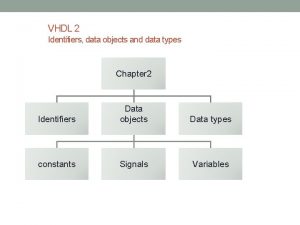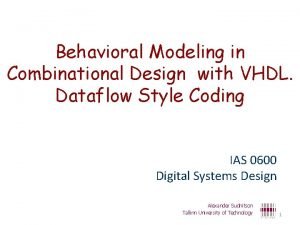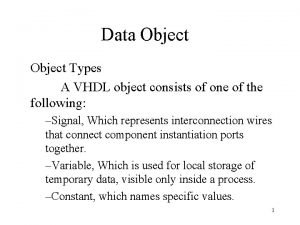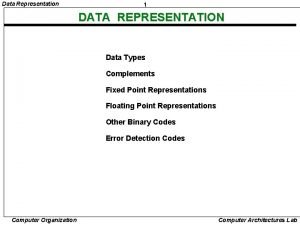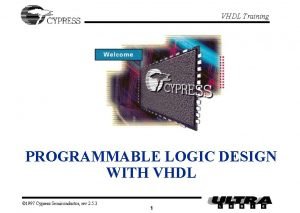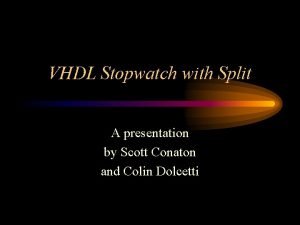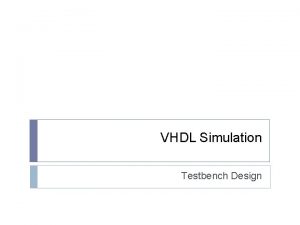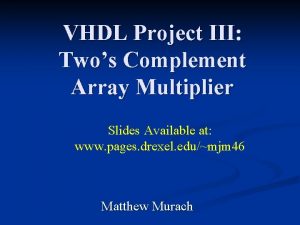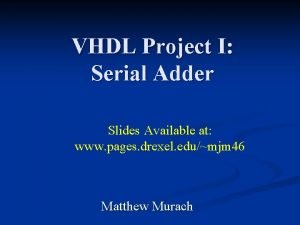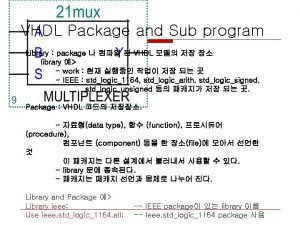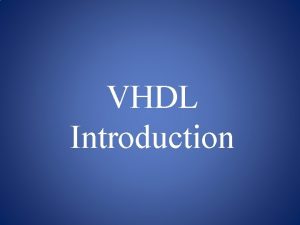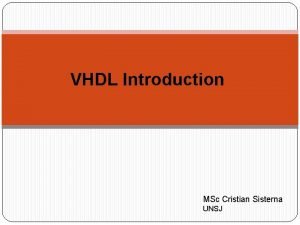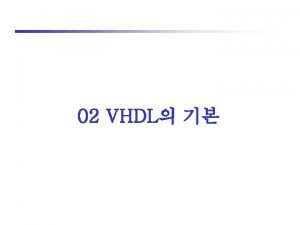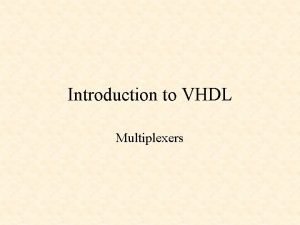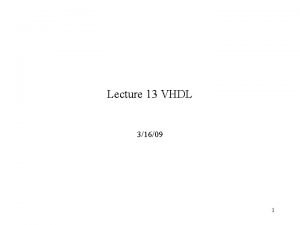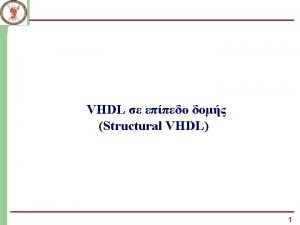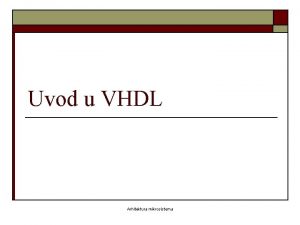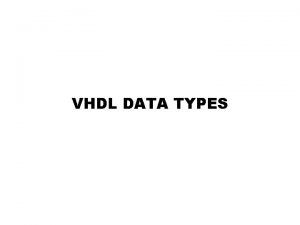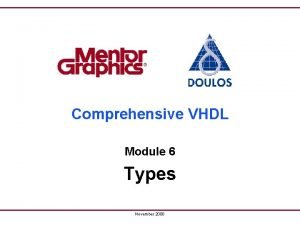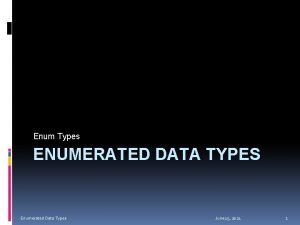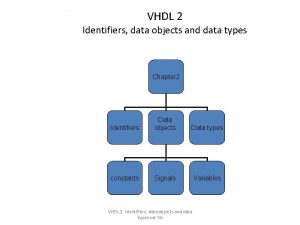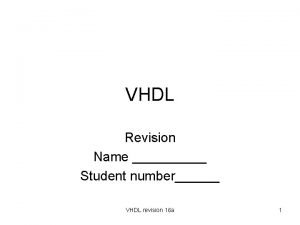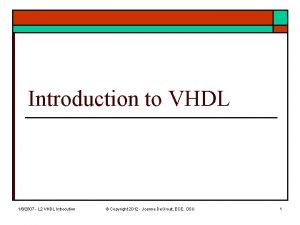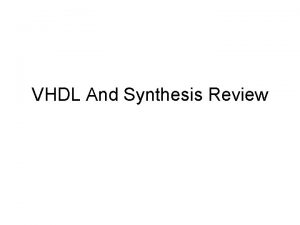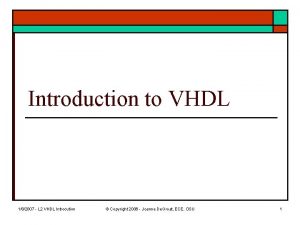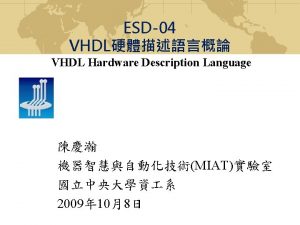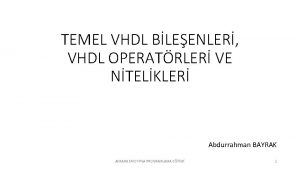VHDL Data Types Module F 3 1 VHDL






















- Slides: 22

VHDL Data Types Module F 3. 1

VHDL Data Types Scalar Integer Enumerated Real (floating point)* Physical* Composite Array Record Access (pointers)* * Not supported by synthesis tools

VHDL Data Objects Constant Variable Signal File* * Not supported by synthesis tools

Identifiers May contain A-Z, a-z, 0 -9, _ Must start with letter May not end with _ May not include two consecutive _ VHDL is case insensitive Sel sel and SEL refer to same object

Identifier Examples A 2 G valid 8 bit_counter invalid -- starts with number _New. Value invalid -- starts with _ first# invalid -- illegal character

Characters and Strings Characters ‘A’, ‘ 0’, ‘ 1’, ‘$’, ’x’, ‘*’ Strings “string of characters” “ 00101101” “ 0 X 110 ZZ 1”

Characters and Strings Bit Strings B” 011111010110” O” 3726” X” 7 D 6”

Integer Data Type Integer Minimum range for any implementation as defined by standard: - 2, 147, 483, 647 to 2, 147, 483, 647 Example assignments to a variable of type integer : ARCHITECTURE test_int OF test IS BEGIN PROCESS (X) VARIABLE a: INTEGER; BEGIN a : = 1; -- OK a : = -1; -- OK a : = 1. 0; -- illegal END PROCESS; END test_int;

Integer Data Type Minimum range for any implementation: 2, 147, 483, 647 to 2, 147, 483, 647 Define range of integer minimizes synthesized logic type Count. Value is range 0 to 15; type Twenties is range 20 to 29; type Thirties is range 39 downto 30; Range should start with 0 Synthesis tools use number of bits as if starting at 0

Example of Integer Data Type process(addr) variable j: integer range 0 to 35; variable addru: unsigned(7 downto 0); begin for i in 7 downto 0 loop addru(i) : = addr(i); end loop; j : = conv_integer(addru); M <= rom(j); end process;

VHDL Data Types Scalar Types (Cont. ) Enumerated User specifies list of possible values Example declaration and usage of enumerated data type : TYPE binary IS ( ON, OFF ); . . . some statements. . . ARCHITECTURE test_enum OF test IS BEGIN PROCESS (X) VARIABLE a: binary; BEGIN a : = ON; -- OK. . . more statements. . . a : = OFF; -- OK. . . more statements. . . END PROCESS; END test_enum;

VHDL Data Types Scalar Types (Cont. ) Real Minimum range for any implementation as defined by standard: -1. 0 E 38 to 1. 0 E 38 Example assignments to a variable of type real : ARCHITECTURE test_real OF test IS BEGIN PROCESS (X) VARIABLE a: REAL; BEGIN a : = 1. 3; -- OK a : = -7. 5; -- OK a : = 1; -- illegal a : = 1. 7 E 13; -- OK a : = 5. 3 ns; -- illegal END PROCESS; END test_real;

VHDL Data Types Scalar Types (Cont. ) Physical Require associated units Range must be specified Example of physical type declaration : TYPE resistance IS RANGE 0 TO 10000000 UNITS ohm; -- ohm Kohm = 1000 ohm; -- i. e. 1 KW Mohm = 1000 kohm; -- i. e. 1 MW END UNITS; Time is the only physical type predefined in VHDL standard

Booleans type boolean is (false, true); variable A, B, C: boolean; C : = not A C : = A and B C : = A or B C : = A nand B C : = A nor B C : = A xnor B

Bits type bit is (‘ 0’, ‘ 1’); signal x, y, z: bit; x <= ‘ 0’; y <= ‘ 1’; z <= x and y;

Standard Logic library IEEE; use IEEE. std_logic_1164. all; type std_ulogic is ( ‘U’, ‘X’ ‘ 0’ ‘ 1’ ‘Z’ ‘W’ ‘L’ ‘H’ ‘-’); -- Uninitialized -- Forcing unknown -- Forcing zero -- Forcing one -- High impedance -- Weak unknown -- Weak zero -- Weak one -- Don’t care

Standard Logic type std_ulogic is unresolved. Resolved signals provide a mechanism for handling the problem of multiple output signals connected to one signal. subtype std_logic is resolved std_ulogic;

Attributes provide information about certain items in VHDL, e. g : Types, subtypes, procedures, functions, signals, variables, constants, entities, architectures, configurations, packages, components General form of attribute use : name'attribute_identifier -- read as “tick” VHDL has several predefined, e. g : X'EVENT -- TRUE when there is an event on signal X X'LAST_VALUE -- returns the previous value of signal X Y'HIGH -- returns the highest value in the range of Y X'STABLE(t) -- TRUE when no event has occurred on signal X in the past ‘t’ time

Operators can be chained to form complex expressions, e. g. : res <= a AND NOT(B) OR NOT(a) AND b; Can use parentheses for readability and to control the association of operators and operands Defined precedence levels in decreasing order : Miscellaneous operators -- **, abs, not Multiplication operators -- *, /, mod, rem Sign operator -- +, Addition operators -- +, -, & Shift operators -- sll, srl, sla, sra, rol, ror Relational operators -- =, /=, <, <=, >, >= Logical operators -- AND, OR, NAND, NOR, XNOR

VHDL Data Types Composite Types Array Used to group elements of the same type into a single VHDL object Range may be unconstrained in declaration • Range would then be constrained when array is used Example declaration for one-dimensional array (vector) : TYPE data_bus IS ARRAY(0 TO 31) OF BIT; 0. . . element indices. . . 31 0. . . array values. . . 1 VARIABLE X : data_bus; VARIABLE Y : BIT; Y : = X(12); -- Y gets value of element at index 12

VHDL Data Types Composite Types (Cont. ) Example one-dimensional array using DOWNTO : TYPE reg_type IS ARRAY(15 DOWNTO 0) OF BIT; 15. . . element indices. . . 0 0. . . array values. . . 1 VARIABLE X : reg_type; VARIABLE Y : BIT; Y : = X(4); -- Y gets value of element at index 4 DOWNTO keyword must be used if leftmost index is greater than rightmost index ‘Big-endian’ bit ordering, for example

VHDL Data Types Composite Types (Cont. ) Records Used to group elements of possibly different types into a single VHDL object Elements are indexed via field names Examples of record declaration and usage : TYPE binary IS ( ON, OFF ); TYPE switch_info IS RECORD status : BINARY; IDnumber : INTEGER; END RECORD; VARIABLE switch : switch_info; switch. status : = ON; -- status of the switch. IDnumber : = 30; -- e. g. number of the switch
 Vhdl data types
Vhdl data types Ver vi
Ver vi C device module module 1
C device module module 1 Vhdl data flow modeling
Vhdl data flow modeling Vhdl data objects
Vhdl data objects Mining complex types of data
Mining complex types of data Data representation forms
Data representation forms Mining complex types of data
Mining complex types of data Complex data types in data mining
Complex data types in data mining Example of claims
Example of claims Udise+ data entry module
Udise+ data entry module Finding answers through data collection module
Finding answers through data collection module Data management module
Data management module Vhdl when else
Vhdl when else Vhdl for programmable logic
Vhdl for programmable logic Colin dolcetti
Colin dolcetti Wzt testbench
Wzt testbench Vhdl 2's complement
Vhdl 2's complement Serial adder vhdl code
Serial adder vhdl code Library ieee vhdl
Library ieee vhdl Vhdl full form
Vhdl full form Vhdl
Vhdl Vhdl hierarchy
Vhdl hierarchy

